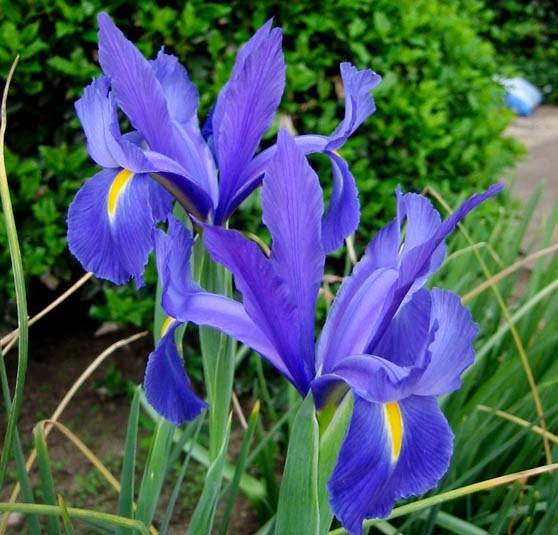The bearded iris
(Iris germanica) are now the queens of the garden. This is the 'dead zone' time of year between perennials and spring bulbs when very little is going on. In May, the bearded iris shine above all else.
Iris comes from the Greek word for rainbow. In Greek mythology, the goddess Iris of the rainbow bore messages between the heavens and the earth. And iris are found in almost every color of the rainbow, but true red has eluded the growers. There are about 300 species of iris native to every continent in the temperate northern hemisphere, but are most prevalent in Europe and the Mediterranean. Because they are easy to cross and breed, there are about 40,000 introduced iris varieties.
The iris has six petals on its flower, although it appears to have three similar ones. It is a great example of a plant developed for pollinators, with a landing pad for flying insects. The entering insect hits the stigma first, depositing its pollen if any. Then, "backing out of the flower" it comes into contact with the plant's pollen, (
after contacting the stigma) and can take it to the next flower. I don't think pollinators actually follow these rules someone thought up -- they just barge in and grab any pollen they can.

Iris have a place in human history. They have been around for centuries, and their symbols appear in ancient Egyptian tombs. The French Crusades brought them back to Europe from Syria, and they were adopted as the famous symbol of the French monarch, the Fleur-de-lis.
 |
| Frank Adams |
|
 |
| Clarence |
|
The Orris root (bearded iris rhizomes) were used for perfumes starting with the Egyptians, who burned them to create scent offerings to the gods. Clothes were boiled with iris rhizomes to perfume undergarments to mask body odors from at least the 1400s. Bathing was considered unhealthy.
Two of my iris have partial shade during the day but are doing very well. "How-to" articles say they do best in full sun and well drained soil. Their maintenance list includes dividing about every three years, more than some of my other perennials, and most of my friends run away now when they see me coming with bags of rhizomes. (If you want any Fantasy Land, drop me a line.) They don't make a good cut flower with each bloom lasting a day or two, and some stink.
 |
| Invitation |
|
 |
| Fantasy Land |
|
The
Historic Iris Preservation Society aims to preserve old iris varieties, and has a huge collection of reference materials to identify and track down old varieties. Some varieties documented in old documents are thought to be lost, however, people believe they still exist in someone's garden somewhere and will be found.
The
history of the American Iris Society is fascinating (to plant geeks and history buffs.) It was founded around 1920 because of confusion (and probably deceit) about varieties -- companies selling varieties after renaming them, developing varieties that someone else did, not documenting parentage.
 |
| Quaker Lady |
In doing the research for this blog post, I believe the identities of the unnamed bearded iris in my yard are now found. Thank you HIPS for your online photo gallery. I swear all iris in the world are here in one gallery or another.
Frank Adams is the spitting image of the one I got at a neighborhood plant swap. It is the tallest, broadest (taking up the most space) and very prolific.
Quaker Lady, growing in the yard when the house was purchased, is certainly an older variety. It is short with smallish flowers and petals that slant outward.
Fantasy Land seems like a match to what I was calling Grape Nehi, although there are no sources on the internet where I can verify this one. It is most prolific and is found in several yards throughout the neighborhood.
Clarence was purchased at Walmart a few years ago - after seeing it in an iris catalog.
Invitation was a gift from the landscape architects who hate bicolor iris, and has stalks that always need to be staked.
Garden Calendar:
• Blooming: azalea, rhododendron, ajuga, wood phlox, iris, allium, salvia |


























